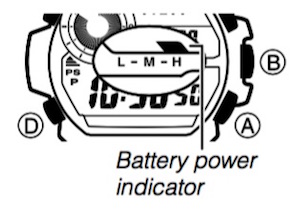Digital Compass Precautions
Magnetic North and True North
The northerly direction can be expressed either as magnetic north or true north, which are different from each other. Also, it is important to keep in mind that magnetic north moves over time.
• Magnetic north is the north that is indicated by the needle of a compass.
• True north, which is the location of the North Pole of the Earth’s axis, is the
north that is normally indicated on maps.
• The difference between magnetic north and true north is called the
“declination”. The closer you get to the North Pole, the greater the declination angle.
Location
• Taking a direction reading when you are near a source of strong magnetism can cause large errors in readings. Because of this, you should avoid taking direction readings while in the vicinity of the following types of objects: permanent magnets (magnetic necklaces, etc.), concentrations of metal (metal doors, lockers, etc.), high tension wires, aerial wires, household appliances (TVs, personal computers, washing machines, freezers, etc.).
• Accurate direction readings are impossible while in a train, boat, air plane, etc.
• Accurate readings are also impossible indoors, especially inside ferroconcrete structures. This is
because the metal framework of such structures picks up magnetism from appliances, etc.
Storage
• The precision of the bearing sensor may deteriorate if the watch becomes magnetized. Because of this, you should store the watch away from magnets or any other sources of strong magnetism, including: permanent magnets (magnetic necklaces, etc.) and household appliances (TVs, personal computers, washing machines, freezers, etc.).
• Whenever you suspect that the watch may have become magnetized, perform the procedure under “To perform 2-point calibration” (page E-52).
Magnetic North and True North
abah
01:43
Archive
-
▼
2016
(
60
)
-
▼
July
(
10
)
- Reading Barometric Pressure Differential Pointer
- Reading the Barometric Pressure Graph
- Reading the Barometric Pressure and Temperature
- Taking Barometric Pressure and Temperature Readings
- Magnetic North and True North
- Magnetic Declination Correction
- Setting a Map
- To Take a Direction Reading
- To Perform 2-Point Calibration
- Taking Direction Readings
-
▼
July
(
10
)
Popular Posts
Subscribe Us
Categories
Tags
Recent Posts
3/recent/post-list
Categories
Tags
Random Posts
3/random/post-list
Menu Footer Widget
Crafted with by TemplatesYard | Distributed By Blogger Template





